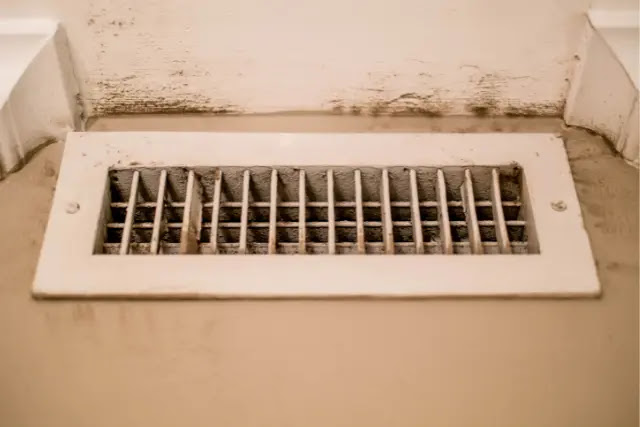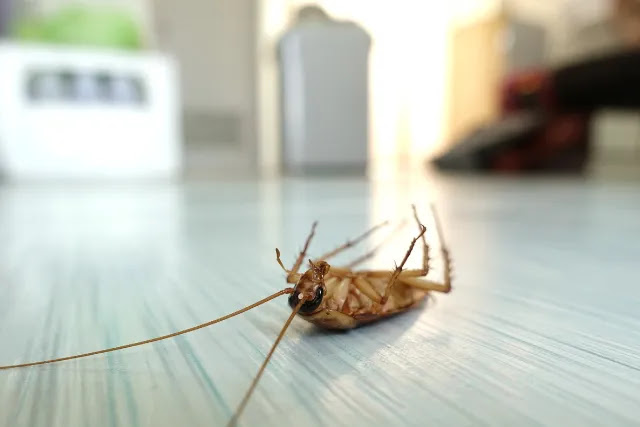Cockroaches are incredibly difficult pests to control because they are so good at hiding during the day. Also, today’s cockroaches have evolved resistance to most pesticides used for their control. Because cockroaches are challenging to get rid of, they are able to breed rapidly and spread throughout the house.
Cockroaches invade homes seeking three basic things – food, water, and shelter. These pesky pests are notorious for squeezing through impossible tight cracks and openings as small as one-tenth-of-an-inch. Once in your house, they can run at an impressively high speed even with their bodies flattened by half.
Nothing frustrates a homeowner more than cockroaches disappearing into the air vent. Unfortunately, these creepy invaders don’t just escape through the air vent; they can also use it as the perfect pathway into your home.
Perhaps you’re wondering how to get rid of roaches in air vents. Read on to find out.
{tocify} $title={Table of Contents}
Why Are Roaches in My Air Vent?
Cockroaches are one of the most notorious little critters in the world. Unfortunately, the inside of your home is a prime target for these cunning invaders. They can take up residence in areas you would never have imagined, such as your air vents.
When establishing a camp, cockroaches look for an undisturbed place with good moisture content, perfect temperatures, and a consistent food supply. The drain pan in your HVAC system always has moisture content due to condensation. On top of that, the HVAC filter traps impurities such as dust, pet dander, hair, skin, and bacteria from the air flowing through the system. This makes your system not only an excellent place for roaches to breed and raise their young ones but also a good source of food, water, and warmth.
Another reason why your air vent is highly vulnerable to cockroach infestations is that these resilient pests are nocturnal. This means they shy away from light and prefer staying hidden in dark places. Roaches are a food source for many predators, such as spiders, beetles, and lizards. Their best chance of living a complete life cycle is by hiding in dark areas during the day, only coming out at night to forage for food in the cover of darkness.
Your Air Vents Are the Perfect Pathway for Roaches
Since we’re going down this path, let’s have a quick overview of how the different components of your AC are located in the interior and exterior of your home. The part of your HVAC system that contains the propeller fan, compressor, and heat exchange coil is known as the condenser.
The condenser unit is usually situated outdoors, where heat from your house is expelled. It is connected with the evaporator unit, which is located inside your home. Once the air is filtered and cooled, the ductwork carries it throughout your house.
When cockroaches are foraging for food, they can check out your home by crawling through any available gaps, cracks, or open spaces. Your HVAC system is a perfect pathway for roaches to access the inside of your home from outdoors. Once inside the vents, the entirety of your ductwork allows them to move unnoticed throughout your house.
So, How Do Roaches Get into My Air Vents?
As mentioned above, cockroaches are sneaky crawlers that can exploit many areas to enter your home. And it is not uncommon for them to make their grand entrance via your air vents.
Maybe you’re wondering, how the h*ll did roaches get into my air vents? Well, cockroaches are known for their climbing prowess. They can enter your air vents through the AC drain pipes that run from the outdoors to the evaporator unit in your home. AC drain pipes are usually located near the outdoor condenser unit.
Cockroaches can also find a faulty seal and crawl into your system. Once inside, they can access every corner of your house through your ductwork. Cockroaches are social insects, often living in family groups. So it’s safe to assume that once you see one cockroach in your air vent, there are many others you can’t see.
Can I Blast Air Through M Air Vents to Stop Roaches from Climbing?
It is a common assumption that blasting air through the vents can stop roaches from climbing the HVAC system. While the force of air can slow down cockroach movement, it cannot stop them from climbing your air vents.
Cockroaches have mastered their climbing skills. They have six legs, each featuring powerful climbing claws that attach tightly to almost any surface. Their legs also have adhesive pads and hair-like structures that allow them to scale vertical surfaces.
On top of that, cockroaches have a pair of sensory organs called cerci at the end of their abdomen. They can sense even the tiniest vibrations through air and on the ground, translating them into advanced warning signs. This is enough heads up for the little invaders to adhere tightly to the surface.
The bottom line is that constant and increased airflow cannot stop roaches from climbing the air vent into your home.
Why You Need to Get Rid of Roaches in Air Vents
Cockroaches are carriers of bacteria, molds, fungi, and viruses. Their shedding body parts, saliva, and feces can trigger asthma and allergies. When cockroach allergens are kicked up in the air, they can worsen asthma and allergy symptoms.
Cockroaches are also bad for indoor air quality. Their allergens and oily, musty odors lower the quality of indoor air. No matter how much you clean your home or freshen your indoor air, the foul odor will keep wafting through your rooms.
The bad news is that the pungent, unpleasant odor gets worse as the infestation grows. Yet, it can be challenging to get rid of roaches in air vents. Often, you will need help from a pest control company or an HVAC professional to get rid of cockroaches once they’ve entered your vents.
Signs of Roaches in Air Vents
Here are some telltale signs that you may be having roaches in your vents:
Cracked or damaged vents: Cockroaches are opportunistic pests who will take advantage of cracked vents to get into your home. Even worse, bigger invaders like rodents can also squeeze into your home via damaged vents.
Lack of screens on vents: Installing vent screens is one of the best ways to keep bugs out of your ventilation system. Screen vents are typically small mesh accessories that you can easily install to stop occurrences of pests like cockroaches and wasps. Comparably, vents that don’t have screens allow cockroaches to squeeze into your home.
Vegetation around your vents: Vegetation is the perfect place for most types of pests to hide. If there is vegetation, shrubs, or branches around your condenser unit, it’s just a matter of time before cockroaches discover the highway to your home.
How to Get Rid of Roaches in Air Vents?
Now that you know how dangerous cockroaches are in your air vents, you’re eager to get rid of them fast and effectively. A significant problem with cockroaches in air vents is that they can be challenging to get rid of, even for pest control experts.
When pest professionals treat your home, they often do not include your air vents and ductwork. Therefore, the best thing to do is prevent cockroaches from entering your air vents. You can do this by installing vent screens, repairing damaged vents, and trimming vegetation around your vents to prevent cockroaches from reaching them.
But if the notorious pests have already gotten into your vents, we have compiled 5 smart ways to help you get rid of roaches in air vents effectively:
Use Diatomaceous Earth or Boric Acid
Diatomaceous earth is a naturally occurring powder extracted from the sediments of fossilized algae commonly found in water bodies. It is one of the most frequently used non-chemical methods to control pests such as roaches, fleas, mites, bed bugs, ants, and other insects with an exoskeleton.
Diatomaceous earth works in two ways. First, it removes moisture from an insect’s habitat, making it impossible for them to survive. And when it makes direct contact with an insect exoskeleton, it dehydrates them to death.
Boric acid also works similarly to diatomaceous earth. All you need to do is place fine dust of either of these powders in areas you suspect or have seen cockroach activity. Ensure the dust is fine enough that you almost can’t see it because if roaches see a pile of dust, they’ll avoid it.
The idea is that roaches will walk through the dust and carry it back to their nest. When the infected roaches groom themselves, they unintentionally ingest the powder, causing tiny cuts in their digestive tract and exoskeleton.
Since they are social insects, their siblings will come to help with the grooming, and they will also die. This method is an excellent alternative to toxic chemicals and has been proven to exterminate an entire insect colony.
Use Heat
Getting rid of roaches in vents may be challenging, but it’s not impossible. Cockroaches are cold-blooded insects, meaning their body temperature varies with the temperature of their environment. This makes it possible to use heat to eradicate them from your air vents.
Roaches can withstand temperatures as high as 110 degrees Fahrenheit for 2-7 hours. However, they cannot survive temperatures above 120 degrees Fahrenheit, forcing them to relocate to a cooler area as soon as possible, failure to which they risk dying.
Generally, when you turn on your system, temperatures in the ductwork can rise to 170 °F, and they’ll be higher as you move closer to the furnace. The heat kills some roaches while forcing others to escape in search of cooler temperatures. This is the best opportunity to catch the escaping roaches in your bait traps.
Fix Any Leaks Around Your Air Conditioner
Cockroaches depend on water for survival. So if you have any leaks around your air conditioner, the high chances are that they will take up residence in your air conditioner. Inspect the areas around your AC to see if there are leaking pipes or dripping water. While some leaks can be fixed with a bit of DIY advice, you may need to call a plumber to assess the damage and make the necessary repairs or replacements.
Clean Your House Regularly and Keep It Cool
Roaches are not picky eaters and thrive in dirty, cluttered environments. They can feed on everything from crumbs, spills, dirt, and dander. They also commonly nest in cluttered and damp places. Therefore, you might want to clean your home thoroughly and regularly to eliminate all possible food, water, and shelter sources.
Roaches also hate cold environments. They prefer temperatures above 77 °F, and anything less than that is too cold for their liking. A clean and cool environment discourages roaches from taking up residence in your home or vents.
Engage HVAC Professionals
This is perhaps the most effective way to get rid of roaches in air vents. You should call an HVAC company immediately if you suspect or have seen roaches going in or out of your air vents. The experts will thoroughly inspect your system and deep clean your ductwork using specialized tools that suck all debris, dander, dust, allergens, and dirt from deep within the system.



